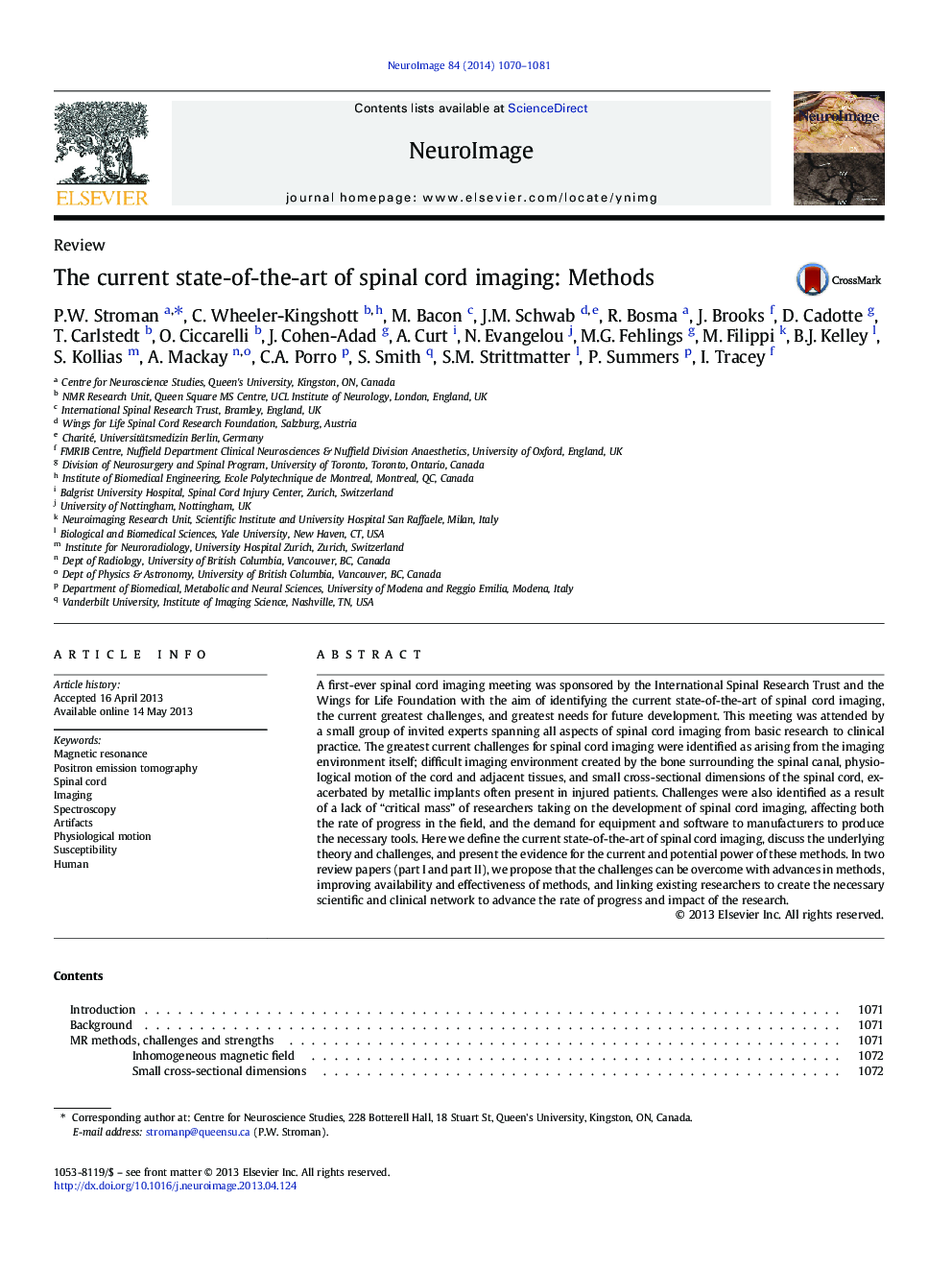| کد مقاله | کد نشریه | سال انتشار | مقاله انگلیسی | نسخه تمام متن |
|---|---|---|---|---|
| 6028657 | 1580920 | 2014 | 12 صفحه PDF | دانلود رایگان |
عنوان انگلیسی مقاله ISI
The current state-of-the-art of spinal cord imaging: Methods
ترجمه فارسی عنوان
وضعیت فعلی تصویر برداری از نخاع: روش ها
دانلود مقاله + سفارش ترجمه
دانلود مقاله ISI انگلیسی
رایگان برای ایرانیان
کلمات کلیدی
تشدید مغناطیسی، توموگرافی گسیل پوزیترون، نخاع، تصویربرداری، طیف سنجی، مصنوعات، حرکت فیزیولوژیکی، حساسیت، انسان،
ترجمه چکیده
اولین ملاقات تصویربرداری بافت نخاعی توسط پژوهش بین المللی تحقیقات ستون فقرات و بنیاد بالهای زندگی به منظور شناسایی وضعیت فعلی از تصویر برداری نخاع، بزرگترین چالش های فعلی و بزرگترین نیاز برای توسعه آینده. این جلسه با گروه کوچکی از کارشناسان دعوت شده که شامل تمام جنبه های تصویربرداری نخاعی از تحقیقات اولیه تا عمل بالینی بود، حضور داشتند. بزرگترین چالش های فعلی برای تصویر برداری نخاعی به عنوان ناشی از محیط محیط تصویربرداری مشخص شده است. محیط تصویربرداری دشوار ایجاد شده توسط استخوان اطراف کانال ستون فقرات، حرکت فیزیولوژیک طناب و بافت مجاور و ابعاد کوچک مقطع نخاعی، که توسط ایمپلنت های فلزی اغلب در بیماران آسیب دیده افزایش می یابد. چالش ها همچنین به عنوان یک نتیجه از کمبود بحرانی مشخص شد؟ از محققانی که در حال توسعه تصویربرداری نخاعی هستند، که بر میزان پیشرفت در زمینه تاثیر می گذارد، و تقاضا برای تجهیزات و نرم افزار به تولید کنندگان برای تولید ابزار لازم است. در اینجا ما وضعیت فعلی تصویربرداری از نخاع را تعریف می کنیم، درباره تئوری و چالش های اساسی بحث می کنیم و شواهدی را برای قدرت فعلی و بالقوه این روش ها ارائه می دهیم. در دو مقاله بررسی شده (قسمت اول و بخش دوم) پیشنهاد می کنیم که چالش ها با پیشرفت روش ها، بهبود دسترسی و اثربخشی روش ها، و ارتباط پژوهشگران موجود برای ایجاد شبکه علمی و بالینی لازم جهت پیشبرد سرعت پیشرفت و تاثیر تحقیق
موضوعات مرتبط
علوم زیستی و بیوفناوری
علم عصب شناسی
علوم اعصاب شناختی
چکیده انگلیسی
A first-ever spinal cord imaging meeting was sponsored by the International Spinal Research Trust and the Wings for Life Foundation with the aim of identifying the current state-of-the-art of spinal cord imaging, the current greatest challenges, and greatest needs for future development. This meeting was attended by a small group of invited experts spanning all aspects of spinal cord imaging from basic research to clinical practice. The greatest current challenges for spinal cord imaging were identified as arising from the imaging environment itself; difficult imaging environment created by the bone surrounding the spinal canal, physiological motion of the cord and adjacent tissues, and small cross-sectional dimensions of the spinal cord, exacerbated by metallic implants often present in injured patients. Challenges were also identified as a result of a lack of “critical mass” of researchers taking on the development of spinal cord imaging, affecting both the rate of progress in the field, and the demand for equipment and software to manufacturers to produce the necessary tools. Here we define the current state-of-the-art of spinal cord imaging, discuss the underlying theory and challenges, and present the evidence for the current and potential power of these methods. In two review papers (part I and part II), we propose that the challenges can be overcome with advances in methods, improving availability and effectiveness of methods, and linking existing researchers to create the necessary scientific and clinical network to advance the rate of progress and impact of the research.
ناشر
Database: Elsevier - ScienceDirect (ساینس دایرکت)
Journal: NeuroImage - Volume 84, 1 January 2014, Pages 1070-1081
Journal: NeuroImage - Volume 84, 1 January 2014, Pages 1070-1081
نویسندگان
P.W. Stroman, C. Wheeler-Kingshott, M. Bacon, J.M. Schwab, R. Bosma, J. Brooks, D. Cadotte, T. Carlstedt, O. Ciccarelli, J. Cohen-Adad, A. Curt, N. Evangelou, M.G. Fehlings, M. Filippi, B.J. Kelley, S. Kollias, A. Mackay, C.A. Porro, I. Tracey,
